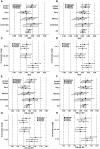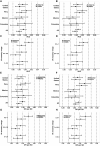Evaluation of Multiple Breast Cancer Polygenic Risk Score Panels in Women of Latin American Heritage
- PMID: 39625644
- PMCID: PMC11799839
- DOI: 10.1158/1055-9965.EPI-24-1247
Evaluation of Multiple Breast Cancer Polygenic Risk Score Panels in Women of Latin American Heritage
Abstract
Background: A substantial portion of the genetic predisposition for breast cancer is explained by multiple common genetic variants of relatively small effect. A subset of these variants, which have been identified mostly in individuals of European (EUR) and Asian ancestries, have been combined to construct a polygenic risk score (PRS) to predict breast cancer risk, but the prediction accuracy of existing PRSs in Hispanic/Latinx individuals (H/L) remain relatively low. We assessed the performance of several existing PRS panels with and without addition of H/L-specific variants among self-reported H/L women.
Methods: PRS performance was evaluated using multivariable logistic regression and the area under the ROC curve.
Results: Both EUR and Asian PRSs performed worse in H/L samples compared with original reports. The best EUR PRS performed better than the best Asian PRS in pooled H/L samples. EUR PRSs had decreased performance with increasing Indigenous American (IA) ancestry, while Asian PRSs had increased performance with increasing IA ancestry. The addition of two H/L SNPs increased performance for all PRSs, most notably in the samples with high IA ancestry, and did not impact the performance of PRSs in individuals with lower IA ancestry.
Conclusions: A single PRS that incorporates risk variants relevant to the multiple ancestral components of individuals from Latin America, instead of a set of ancestry-specific panels, could be used in clinical practice.
Impact: The results highlight the importance of population-specific discovery and suggest a straightforward approach to integrate ancestry-specific variants into PRSs for clinical application.
©2024 The Authors; Published by the American Association for Cancer Research.
Conflict of interest statement
E.M. John reports grants from the NIH during the conduct of the study. L.H. Kushi reports grants from the NIH during the conduct of the study. L. Fejerman reports grants from the NIH and Precision Medicine Initiative Office of the Governor during the conduct of the study and grants from Gilead Corporation outside the submitted work. No disclosures were reported by the other authors.
Figures




References
-
- Sedeta E, Sung H, Laversanne M, Bray F, Jemal A. Recent mortality patterns and time trends for the major cancers in 47 countries worldwide. Cancer Epidemiol Biomarkers Prev 2023;32:894–905. - PubMed

